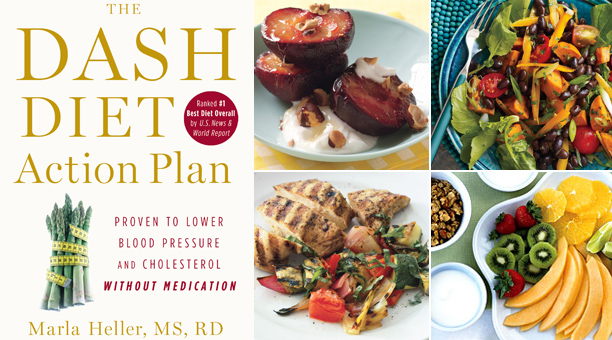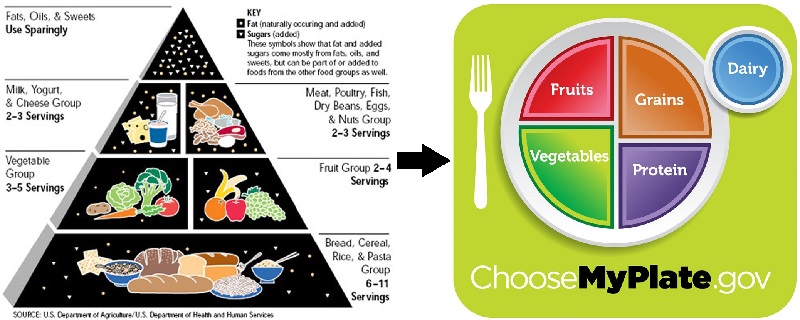Report on Doctor’s Healthiest Diet
Summary: Comparing the Atkins, Rosedale, Paleo, Mediterranean and DASH Diet plans, researchers report on the healthiest options. [This article first appeared on the LongevityFacts website. Author: Brady Hartman.]
Despite all the advances made with lifespan-extending drugs, a healthy diet remains as one of the best ways to stay healthy and live longer. While many dietary regimens can help us lose weight, few people recognize that some of these are downright unhealthy. However, given the multitude of meal plans – such as the Atkins, Rosedale, Paleo, DASH, Mediterranean and the ‘USDA MyFoodPlate’ – which diet is the best for a slim figure and optimal health?
The optimal diet is one that can help us live longer healthier lives while staying slim. Once a person has slimmed down, following a balanced diet that provides optimal nutrition will help us keep live longer and in better health.
The Low Carb Atkins Diet
The Atkins Diet emerged a few decades ago as a popular fad diet. The diet – named after its developer, Dr. Robert Atkins – is based on avoiding all carbohydrates and puts no limit on foods rich in protein and fat, such as nuts, eggs, fish, meat and non-starchy vegetables.
While the Atkins diet purported to help people lose weight, there is only weak evidence supporting its effectiveness in helping achieve sustainable weight loss
Dr. Atkins believes that starchy carbs are the main culprit behind weight gain, because they induce the body to overproduce insulin, depleting blood glucose and in turn, making people feel hungry even after consuming more calories than their bodies need. The Atkins Diet was very controversial at the time, and, when Dr. Atkins had a non-fatal heart attack in 2002, his critics blamed his high-fat diet.
Proponents of the Atkins plan claim that carbs – as opposed to fats – cause weight gain and an increase in cholesterol levels. Moreover, eating foods high in cholesterol, such as steaks and eggs, does not raise cholesterol levels, however eating potatoes and gulping sugary soft drinks certainly does.
This recommendation doesn’t imply that we can eat as much fatty food as want without gaining weight. Consuming more calories than we burn will always lead to weight gain. However, the key distinction of the Atkins plan is that fat and protein does not cause our blood glucose levels to spike in the same way as refined carbs.
Scientists are divided on whether fats are healthy, but all agree that we should follow a balanced diet comprised of fats, protein, and carbs. Because it eschews carbs, the Atkins diet is unbalanced, and it runs contrary to the bulk of evidence as to what the majority of experts consider to be healthy eating.

Paleo Diet
The Paleo Diet is based on the premise that, before humans became farmers around 10,000 years ago, we were hunter-gatherers, eating whatever we could find. The creators of the Paleo diet assume that this hunter-gatherer diet helped to ensure survival as well as reproduction.
The idea of a Paleolithic diet can be traced to a 1975 book by Dr. Walter Voegtlin, a gastroenterologist. In 1985 the concept was further developed by Stanley Boyd Eaton and Melvin Konner. The idea was popularized by Loren Cordain in his 2002 book The Paleo Diet.
The Paleo Diet is based on eating unprocessed foods from all the major food groups such as meats, seafood, nuts, fruits, and vegetables. These foods reduce the body’s glycemic load and contain a healthy range of proteins, fats, and carbohydrates, as well as all the vitamins and other nutrients we need.
Science has to prove the health benefits of the Paleo Diet. While the Paleo is healthier than the modern Western diet, it is not clear whether it leads to longer lifespans. One study published in 2015 showed that following the Paleo diet can lead to an inadequate calcium intake.
The central appeal of the Paleo Diet is that allows you to eat until you feel full. It is quite similar to the Atkins Diet in that it avoids most carbs, such as bread, rice, and pasta. The core foods of the Paleo Diet include meat, eggs, poultry, fish, oils, tubers, nuts and fruits, and vegetables. The general mix of caloric intake is roughly equally divided among fats, carbs, and protein.
Low Carb Rosedale Diet
To live a long and healthy life, Dr. Ron Rosedale believes that we should all be following a high-fat, ketogenic diet. Our bodies enter a state of ketosis when it is deprived of carbs and resorts to burning fat as a source of energy.
Dr. Ron Rosedale is firmly against having too much protein in the diet. Rosedale believes that while the Paleo Diet may optimize us for reproductive success, it will not necessarily make us live longer.
Dr. Rosedale recommends that we keep our protein intake to no more than 1 gram per day for every kilogram of lean body mass. Rosedale doesn’t like carbs either and believes that fats burn more cleanly. Rosedale sums up his dislike of carbohydrates, saying
“Health and lifespan is determined by the proportion of fat versus sugar people burn throughout their lifetime. The more fat that one burns as fuel, the healthier the person will be, and the more likely they will live a long time. The more sugar a person burns, the more disease ridden and the shorter a lifespan a person is likely to have.”
Dr. Rosedale believes that mTOR, which stands for ‘mammalian target of rapamycin,’ is the most important signaling pathway in the body. The mTOR pathway is common to nearly all organisms, including bacteria. Rosedale also believes that mTOR activation stimulates virtually all cancers.
Dr. Rosedale discovered that his high-fat ketogenic diet worked well with patients suffering from diabetes and heart disease and believed it should be a diet for everyone wishing to optimize health and longevity.
To summarize, Rosedale recommends we keep our carbohydrates low, proteins moderate and fats high. The Rosedale diet is unbalanced and thus runs contrary to the bulk of nutritional advice which advises us to eat a low-fat, balanced diet to preserve health and lose weight.

DASH Diet
The DASH diet was developed by a team of doctors and nutritionists at the U.S. National Heart, Lung, and Blood Institute NHBLI – part of the National Institutes of Health (NIH). As its full name suggests – Dietary Approaches to Stop Hypertension – the DASH diet was originally designed to prevent and control hypertension. However, it appears the diet is good for our health and waistlines as well.
In fact, in 2017, U.S. News & World Report (USNWR) named DASH as number 1 in the categories of “Best Diets Overall,” “Best Diets for Healthy Eating,” and “Best Diet for Diabetes” in their annual “Best Diets” rankings of 38 diets.
In her book, The DASH Diet Action Plan: Proven to Lower Blood Pressure and Cholesterol Without Medication, Marla Heller describes the theory behind the DASH diet, saying that nutrients such as potassium, calcium, and magnesium are crucial to fighting high blood pressure. You don’t have to track each mineral, though.
The DASH diet plan emphasizes the foods you’ve always been told to eat, such as low-fat dairy, whole grains, lean protein, fruits, vegetables and includes meat, fish, poultry, nuts, and beans. The DASH diet limits the consumption of salt, sugar-sweetened foods and beverages, red meat, and added fats. In addition to its effect on blood pressure, the DASH diet was designed to be a well-balanced approach to eating for the general public. The United States Department of Agriculture (USDA) recommends DASH as one of its ideal eating plans for all Americans.

Mediterranean Diet
The public has become increasingly fascinated with the Mediterranean diet in recent years, spurred by some published studies which suggest that it is the optimal diet for nutrition and health. The diet is based on the observation that people living in Mediterranean countries have low rates of heart disease. This view has been attributed to the fact that residents of the region consume a diet with plenty of fish, chicken, nuts, olive oil, fresh vegetables and a moderate wine intake.
The diet was popularized by American physiologist Ancel Keys, Ph.D. Keys spent his entire professional life studying the influence of diet on health. Keys has studied a wide variety of the effects of diet on health, including the effects of calorie restriction. In particular, the physiologist studied the epidemiology of cardiovascular disease (CVD) and hypothesized that dietary saturated fat causes cardiovascular heart disease and should be avoided. Dr. Keys was responsible for two famous diets: K-rations formulated as balanced meals for combat troops in World War II, and the Mediterranean diet.
Dr. Keys first recognized the health benefits of the Mediterranean diet while living in a small Italian village called Pioppi in the 1970s. In 1975, he and his wife Margaret published the book How to Eat Well and Stay Well the Mediterranean Way.
Keys recognized that the diet of the Pioppi villagers was high in fresh vegetables and very low in sugar. Keys also discovered that older adults from the region tended to have unusually good blood circulation, helping to keep their cells nourished and enabling efficient waste removal.
Proponents of the Mediterranean diet say it produces weight loss and promotes heart and brain health, helps to prevent cancer, and prevents and controls diabetes.
The Mediterranean diet is low in red meat, sugar and saturated fat and high in fruits, veggies, and nuts. The diet emphasizes eating whole grains, beans, nuts, fruits, vegetables, legumes, olive oil, all the while topped off with flavorful herbs and spices. The diet recommends eating fish and seafood at least a couple of times a week while consuming poultry, eggs, yogurt, and cheese in moderation. The Mediterranean diet recommends saving sweets and red meat for special occasions. The diet also recommends drinking red wine in moderation. However, recent research has called the health benefits of even modest amounts of alcohol consumption into question.

USDA MyFoodPlate and Food Pyramid
The Food Pyramid was first published in 1977 by the US Department of Agriculture (USDA). The diet was prepared by a team of physicians and nutritionists at the USDA and was the first time anyone had tried to quantify and categorize our food for a healthy, balanced diet.
The Food Pyramid lasted for decades until experts pointed out its many flaws. Nutritionists often criticized the food pyramid for being misleading or hard to understand. Most importantly the proportions recommended by the Food Pyramid do not promote a healthy weight. The Food Pyramid emphasis on eating plenty of carbs, such as pasta, bread, and rice and has been a significant contributor to the worldwide obesity epidemic leading to type 2 diabetes.
In 2011, at the urging of Michelle Obama, the USDA relegated the well-known food pyramid to the sands of history, replacing it with a simpler image of a plate divided into basic food groups. The new design, called MyPlate, was conceived as a crucial part of Mrs. Obama’s campaign against obesity, designed to remind people about the basics of a healthful diet.
MyPlate was a change from the Food Pyramid in that it encouraged people to fill half their plate with fruits and vegetables. Plant foods provide phytonutrients, known for their health benefits. And while the plate is easier to understand than the pyramid, nutritionists criticize labeling a large section of the plate “protein” as being unnecessary and confusing, because grains and dairy products also are important sources of protein and most Americans get far more protein than they need. However, nutritionists say the emphasis on fruits and vegetables is a significant step in the right direction, and MyPlate is a welcome improvement over the Food Pyramid.
Fasting Mimicking and 5:2 Diets
Moreover, how much we eat plays a role in our health and lifespan. The practice of calorie restriction extends the lifespan on laboratory animals, and evidence is starting to hint that intermittent fasting might do the same. Intermittent fasting, such as with the Fasting Mimicking Diet or the 5:2 diet, improves markers in humans in the same way as in laboratory animals. On the flip side, becoming fat leads to poorer health and a shorter life expectancy.
Fasting regimens aren’t traditional diets, but rather overlays which can be combined with healthy eating patterns, such as the DASH diet, although it requires a bit of tweaking. You can learn more about the Fasting Mimicking Diet in this report.
Takeaways
The diets outlined in this article were formulated by doctors and nutritionists, with each group claiming that theirs is the healthiest.
Too many diets require us to count the percentage of protein vs. carbs vs. fats, which is not only time-consuming they place emphasis on the wrong culprits. More important than the quantities of carbs or fats is the quality of these macronutrients. Moreover, these commercial diets overlook fiber, a nutrient that helps us feel full and provides other health benefits.
A healthy eating plan, according to the National Heart Lung and Blood Institute (NHLBI), is one which
“Emphasizes vegetables, fruits, whole grains, and fat-free or low-fat dairy products. Includes lean meats, poultry, fish, beans, eggs, and nuts. Limits saturated and trans fats, sodium, and added sugars. Controls portion sizes.”
This is consistent with a 2014 review by Katz and Miller. After comparing most of the major plans, including the Atkins, Rosedale, Paleo, Mediterranean and DASH diet, the authors said,
“A diet of minimally processed foods close to nature, predominantly plants, is decisively associated with health promotion and disease prevention.”
Bearing that in mind, while all diets have their plusses and minuses, there are several takeaways:
Fats are not unhealthy in and of themselves. However, the wrong kinds of fats are unhealthy. Fats from plant foods are healthier than those from animal sources, and fish and chicken are healthier than red meats.
Eating the wrong kind of carbs is unhealthy while eating the right kind is healthy, up to point. The bulk of the evidence shows that processed foods are unhealthy, especially sugar and refined grains found in bread, rice, and pasta. In fact, a study of the fruit and vegetable consumption of over 2 million people published earlier this year showed that carbs are incredibly healthy when consumed in the form of fresh fruits and vegetables.
Related Articles
- Runoff pitting low-fat vs. low-carb results in a tie when it comes to weight loss.
- Lose weight with these tips on how to get 10 servings of fruits and vegetables daily.
Show Us Some Love
- Share this post on social media and help us spread the word– It only takes one click on any of the social media links on this page.
- Follow us on social media – Google+ | Facebook | Reddit
- Sign up for our email list – We use your email to notify you of new articles. We will not send you spam, and we will not share your email address. You can cancel at any time.
- Tell us what you think – Scroll down to enter your comments below.
References
D.L. Katz and S. Meller. “Can We Say What Diet Is Best for Health?” Annual Review of Public Health 2014 35:1, 83-103. Link to article.
Giovanni Tarantino, Vincenzo Citro, Carmine Finelli. “Hype or Reality: Should Patients with Metabolic Syndrome-related NAFLD be on the Hunter-Gatherer (Paleo) Diet to Decrease Morbidity?” Journal of Gastrointestinal and Liver Diseases. September 2015, Volume 24, Number 3, Article 13. Link to article.
Ron Rosedale. “Burn Fat, Not Sugar to lose weight.” Web. drrosedale.com. Link.
U. S. News & World Report Wellness. “U.S. News Best Diet Rankings”. U.S. News & World Report LP. Retrieved Dec 25, 2017. Link to article.
Marla Heller. “The DASH Diet Action Plan: Proven to Lower Blood Pressure and Cholesterol Without Medication.” Grand Central Publishing, 12 Sep 2011
Aseem Malhotra and Donna O’Neill, “The Pioppi Diet: A 21-Day Lifestyle Plan.” Penguin (2017)
United States Department of Agriculture (USDA), Department of Health and Human Services (HHS) “Dietary Guidelines for Americans, 2015-2020,” 8th Edition; United States Department of Agriculture. 2016, ISBN: 9780160934650. Available Online.
Disclaimer
Diagnosis, Treatment, and Advice: This article is intended for educational and informational purposes only and is not a substitute for qualified, professional medical advice. The information and opinions provided herein should not be used during any medical emergency or for the diagnosis or treatment of any medical condition. Consult a qualified and licensed physician for the diagnosis and treatment of any and all medical conditions. Call 911, or an equivalent emergency hotline number, for all medical emergencies. As well, consult a licensed, qualified physician before changing your diet, supplement or exercise programs. Photos, Endorsements, & External Links: This article is not intended to endorse organizations, companies, or their products. Links to external websites, mention or depiction of company names or brands, are intended for illustration only and do not constitute endorsements.

Great Job,
Really excellent review of all the different diets.
thank you, Doctor.